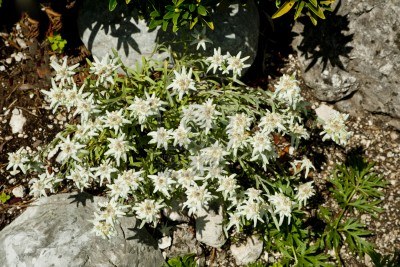 |
| Edelweiss |
Back in the 1960's &1970's
when I was growing up rockeries were popular garden features. I
remember them looking like burial mounds with chunks of stone
sticking out and inexpertly filled with Aubretia and Alyssum. I thought
they were awful then and still do today. They had smaller cousins caused by the
modernising of kitchens; sink gardens. Beautiful old Butler of
Belfast sinks were wrenched out of kithcens and left in gardens where enterprising gardeners would cover them with a mix of cement and compost to give a
'natural look' and then they were filled with an assortment of Sempervivums and
Sedums and maybe a couple of rocks for good measure. The combination of these two
ways of planting alpines put me off them for many years. However,
spending time in the garden centre at work I have seen some very
pretty and interesting plants labelled as Alpines. This has stirred
my curiosity and opened my mind to a previously ignored area of the
garden.
 |
| Sad Sink before I removed the marigolds |
When I wrote about containers I
mentioned the old sink by the front door which hasn't been very
successful with traditional annuals. I have decided to empty it out
and start again once any bulbs have finished flowering, assuming some have survived. It was this
decision which made me think about trying out a few alpines. So off I
went to the internet and Dr Hessayan's books to find out more. I
needed to find out what planting medium they like, do they all like
the blazing hot afternoon sun, can I have a set colour scheme or is
it dictated by size and location. I have set myself quite a
challenge.
 |
| My Friend Lithodora! |
Once the sink has been emptied
and cleaned out (at this stage it can be covered with a mix of cement
and compost to make it look natural!!) I need to cover the plughole
with fine mesh to stop slugs getting in, I shall also block the
overflow which has been home to many small snails in the winter. I
then need to add a layer of drainage material, gravel or stones. On
top of that some people add a layer of rotted turf, some a mixture of
charcoal and grit, or leafmold to act as a filter. Then comes the main
growing mix of grit, peat, top soil, sharp sand – it seems every
alpine grower has their own special formula. Some recommend using
John Innes No2 instead of topsoil as it feeds the plants gradually.
On top of this a layer of gravel is added, along with one or two
rocks to break it up and house some crevice living plants.
 |
| Aquilegia flabellata |
 |
| Iberis Little Gem |
Plants need to be chosen
carefully, many alpines spread from 12 to 18 inches which would soon
swamp my little sink. I have found that in general Alpines are a very
difficult bunch to keep happy; some like shade while others need full
sun, some like to hide in crevices, some love acid soil, others love
chalky soil, some are hardy whilst others are very tender. I found a
website which listed dwarf varieties suited to sinks, I then needed
to sort out which ones liked full sun and agreed with others about
soil type.
 |
| Dianthus Evening Star |
I have given up considering a
colour theme, I shall just be glad if they all get on well together!
 |
| Erysimum Orange Flame |
Despite this there still seems to be a wide variety to choose from; Aquilegia, Dianthus, Phlox and
Saxifrage have an assortment of colours to choose from. Then
there are Leontopdium (Edelweiss, not very imaginative I know but I
am a beginner!); Iberis (Candytuft) Little Gem; Androsace (Rock
Jasmine) Lanuginosa; Campanula Garganica;and Lithodora Olefolium.
There is still a lot of research to be done here I think but
ultimately what it will boil down to is what is available in the
local garden centres. I shall keep you posted.......
Ooops! How did those three
frozen fuchsias get into my luggage boot?! #PlantRescue!
No comments:
Post a Comment